This was published 3 years ago
Jury feedback revealed for rival Powerhouse designs
By Linda Morris
The jury that judged the international design competition for the Parramatta Powerhouse dismissed the only submission that retained historic sites because it was "problematic" and blocked the public connection between river and city.
Six months after the seven-member jury, chaired by notable philanthropist Naomi Milgrom, determined the hyper-platform building design of Moreau Kusunoki and Genton as the "standout, simple and elegant solution", the rationale has been publicly released.
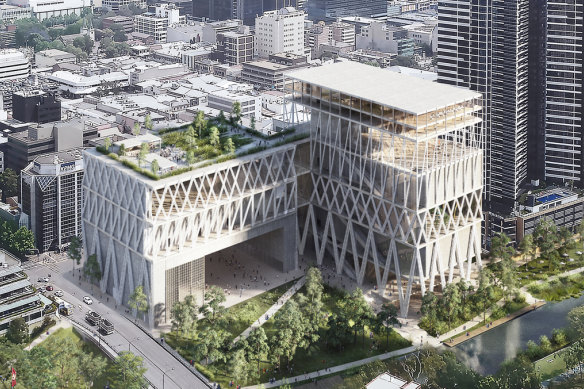
The winning Powerhouse Museum design, by architects Moreau Kusunoki and Genton.
The winning design for the new museum controversially calls for the demolition of two historic buildings: a 19th-century Italianate villa Willowgrove and a row of seven terraces known as St George's Terrace.
While Steven Holl Architects and Conrad Gargett retained the two heritage buildings in their homage to conical Aboriginal fish traps, the jury said their proposed use of these buildings as dining and food facilities was incompatible with "any potential argument for retention".
The juxtaposition of the very large museum building and the smaller heritage structures was also considered jarring.
Bernardes Architecture and Scale Architecture retained St George's Terrace but its "elegant and simple" design with generous presentation and back-of-house spaces were judged not to have conveyed a sense of Parramatta's DNA.
Two weeks ago, the Berejiklian government recommitted to relocate the Powerhouse Museum at Ultimo to the banks of the Parramatta River, a project estimated by its own economic analysis in 2018 to be $1.17 billion.
Taxpayers will need to contribute $645 million towards that cost, the difference to be made up through philanthropy and redevelopment of the Ultimo site.
The rival design finalists were:
Steven Holl Architects and Conrad Gargett, who envisioned an "anthropological vessel ‘touching the earth lightly', combining state-of-the-art technology, maximum flexibility and large spaces with exposed structure and circulation". The tubular main presentation space was inspired by the mandjabu, the fish traps made by Aboriginal people.
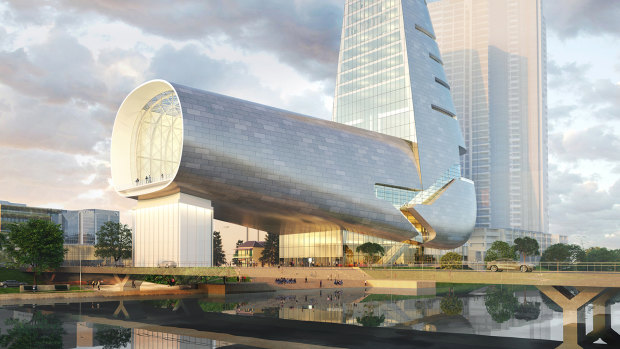
Steven Holl Architects and Conrad Gargett.
The jury praised the courage and ambition of the team's design and its aim to maximise public space, achieve net-zero emissions and concentrate museum functions, as well as the generous public plaza achieved by lifting the building off the ground. But the jury was concerned by the lack of shading. The height and scale of the building were assessed as too dominant within the site and its context. While the two heritage buildings would be kept, the jury said their proposed use as food and beverage facilities was incompatible with "any potential argument for retention". "The result of retaining Willow Grove was considered particularly problematic as the building interrupts the Civic Link, blocking the direct connection of the city and the river," Ms Milgrom said.
Bernardes Architecture and Scale Architecture proposed a building that was "fine-grained, approachable and porous" and would be instantly recognisable as a meeting place by providing one of the best public squares in the world. "The new Powerhouse will set a benchmark for sustainable design and development while providing an internationally recognised cultural institution for Sydney," the architects said.
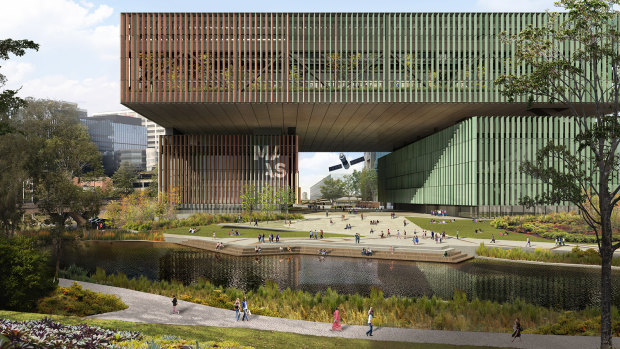
Bernardes Architecture and Scale Architecture.
The jury commented on the elegant and simple design that was inspired by a distinctively Brazilian approach to public space in cultural institutions. The design allowed for a large void under the museum which could be used for public space and a patterned landscape approach. The jury found the operational side of the design was strong with generous allowance for back-of-house spaces and an efficient and consistent layout far in excess of the brief requirements. "The facade, however, was not conceived in response to the site, and the design lacked specific inspirations that related to the site, its culture and people," Ms Milgrom said. "Crucially, it failed to convey a sense of Parramatta's DNA."
Chrofi with Reko Rennie envisaged a design in which "quiet structures of immense scale appear to lean toward each other playfully, drawing visitors in from the city". In this design, apertures in the buildings framed city and river views with a serious of spaces culminating in a "River Square, a city-scale event space that metaphorically pulls the river into the city".
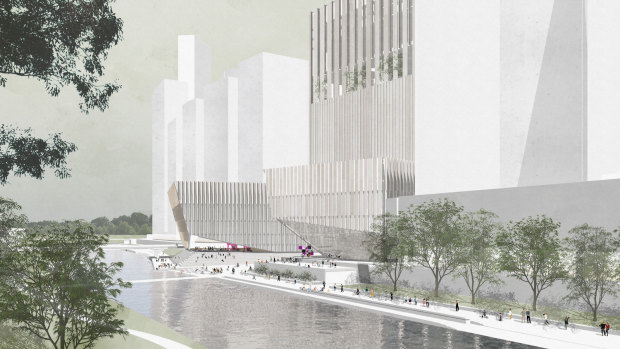
CHROFI with Reko Rennie.
The jury saw this design as a bold if risky approach to the distribution of museum functions and were concerned the three buildings created problems with circulation and connectivity and passages that were too narrow. With high-rise buildings on either side, the passageway suffered from a lack of public space and was not perceived as inviting. Overall, the judges found there was a lack of green space, planting and shading, and an over-reliance on water elements to provide environmental protection. The jury was concerned about plans to build a basement in the flood plain.
AL_A and Architectus envisaged a new Powerhouse "as alive and vibrant as the Lanes on a festival day and as full of energy and anticipation as an Eels match". "That is why we are putting public spaces first — making the river bank a place of convening, letting the city flow below the buildings and up into the museum, creating laneways in the sky," the proposal said. "The milky white facade reflects the weather and ripples like the river. The stringybark timber soffits, triangulated in form, reference the traditional Nowi canoe and make the precinct a warm and inviting place to be."
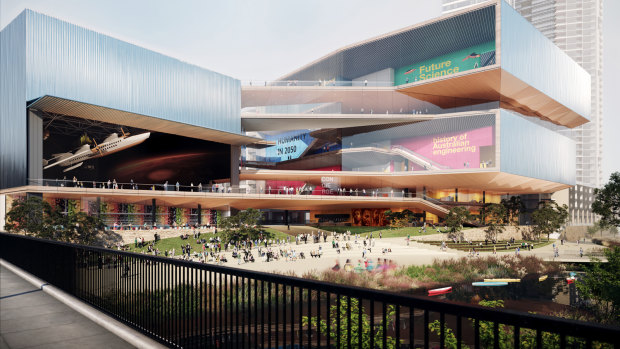
AL_A and Architectus' shortlisted design.
The jury praised the approach to lift the museum off the ground and leave an open public space below with retail, dining and bars well outside of the flood risk. It also admired the drama and presence of the main presentation space. But the jury had concerns about the building's circulation. Its facade, though poetic, presented as a large block to the city and offered large expanses of glass on the riverfront exposing the building to solar heat gain.